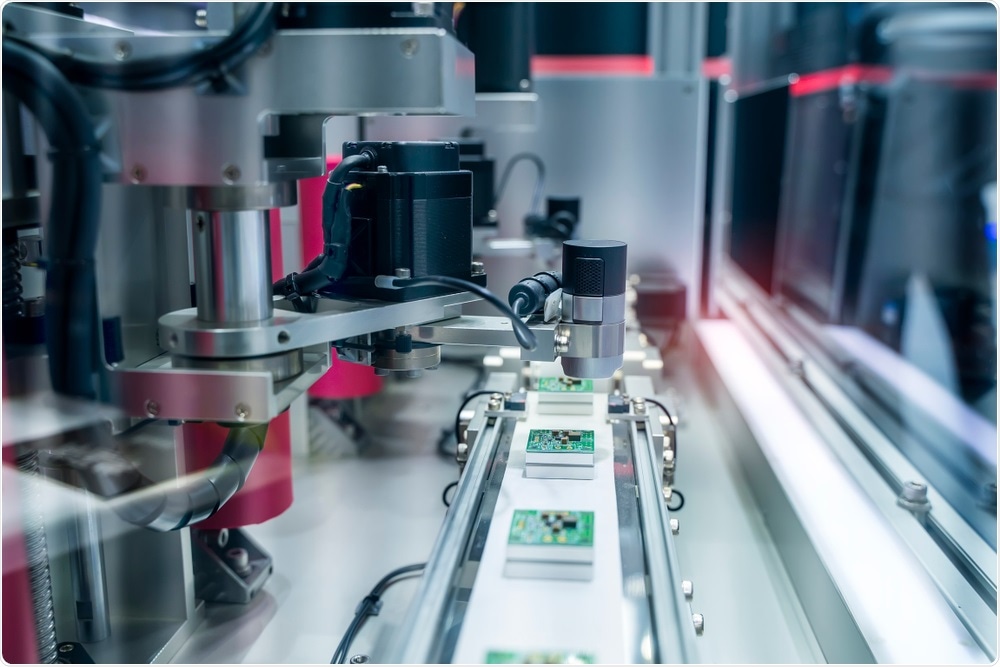In the context of the coronavirus disease 2019 (COVID-19) pandemic, several studies have discussed the development of point-of-care (PoC) testing devices and biosensors for the diagnosis and identification of the severe acute respiratory syndrome coronavirus 2 (SARS-CoV-2).
A review published in the American Chemical Society's journal ACS Omega discusses paper-based devices and platforms targeting SARS-CoV-2 for low-cost PoC diagnosis and serological antibody testing. This review also discusses devices targeting inflammatory markers relevant for COVID-19.
 Study: Paper-Based Biosensors for COVID-19: A Review of Innovative Tools for Controlling the Pandemic. Image Credit: asharkyu / Shutterstock.com
Study: Paper-Based Biosensors for COVID-19: A Review of Innovative Tools for Controlling the Pandemic. Image Credit: asharkyu / Shutterstock.com
Need for new diagnostic tests
Reverse transcriptase-polymerase chain reaction (RT-PCR) is the primary diagnostic assay used for the detection of SARS-CoV-2 viral ribonucleic acid (RNA) in oropharyngeal swab samples. This is the current gold standard for diagnosis and testing because it is highly sensitive and specific.
However, RT-PCR is a time-consuming process that requires specific reagents, zyrtec and clonidine interaction specialized personnel, and equipment. Therefore, this technique cannot be widely used for contact tracing. Moreover, it is usually performed after the onset of symptoms.
This test also has some analytical limitations including the possibility of false positives and negatives. Differences have been observed in the performance of different test kits.
Due to the limitations of RT-PCR, there remains a need for fast, accurate, and readily available tools for controlling this pandemic. To this end, PoC testing or near-patient testing refers to a test performed near the patient outside of the laboratory setting.
PoC devices and biosensors are simply operated, cost-effective, and easily employed in areas with lower accessibility to centralized healthcare and well-equipped laboratories. Along with the development of therapeutic approaches and vaccines for SARS-CoV-2, there is a high demand for scientists to develop new highly accessible biosensors.
Paper-based devices
Biosensors using cellulose and its derivatives are beneficial due to their availability and improved environmental safety profile. Even before the COVID-19 pandemic, many approaches have been developed to achieve a successful biosensor on cellulose-based substrates.
These include immobilizing specific reagents that react with a given compound or group of compounds from the sample on these substrates. This reaction is then translated by monitoring visible alterations or electrochemical detectors.
Other types of paper-based sensors include microfluidics on paper or simple dipping/casting methods that are similar to the common pH paper method. Another example is the glucose meter that is made on a paper substrate.
There are many types of cellulose paper and its chemically-derived materials that have been used in biosensors, which allow for fine-tuning these devices. Paper is suitable for making such devices because it is compatible with most reagents, can be chemically modified for different functions, and has high thermal and mechanical strength.
Moreover, paper can also withstand different manufacturing processes required for making the analytical device. Paper is not just a carrier of reagents but also actively allows sampling, filtration, separation, and reagent/sample mixing.
The most commonly used paper-based device is the lateral flow assay (LFA) test strip that is often incorporated into immunoassays. Microfluidic paper-based analytical devices (μPADs) further enhance the functionalities of paper-based devices.
Paper-based devices for viral RNA testing
Viral RNA that is extracted from an oropharyngeal swab can be directly measured in a PoC setting using various different analytical methods. These include:
- Clustered regularly interspaced short palindromic repeats (CRISPR)-based RNA identification with paper-based
- LFA signal readout
- Fluorescence LFA format device for RNA detection
- Reverse transcription loop-mediated isothermal amplification (RT-LAMP) RNA detection in a microfluidics-based
- A multifunctional device that carries multiple tasks of the molecular diagnosis assay
- An electrochemical paper-based platform for amplification-free RNA identification and diagnosis, using single-stranded deoxyribonucleic acid (ssDNA) probes and graphene/gold electrodes modified with conjugated gold nanoparticles.
Paper-based devices for viral antigen sensing
SARS-CoV-2 can be identified in a sample through the detection of viral antigens specific to the virus including the nucleocapsid protein (N) and spike protein (S). The SARS-CoV-2 S antigen can be detected in the LFA format by using the angiotensin-converting enzyme 2 (ACE2) receptor as a capture molecule for flowing immunocomplexes.
Sialic acid is another chemical used to detect S antigen in the LFA format. This circumvents the need for antibodies and immunoassay-based detection of this antigen. Another LFA device for S antigen detection employs nanozymes and chemiluminescence signaling, which allows portable reading using smartphone readout.
Using the LFA system, the N antigen can be detected by fusion antibodies produced from cloned phages. One device detects S and N antigens simultaneously using the LFA system with up-converting nanoparticles and a 5G-enabled fluorescence sensor for IoT applications. Likewise, the ReScan performs a high-throughput, proteomic detection of S and N antigens and their subunits by printing antibodies targeting the antigens in a nitrocellulose substrate.
Surface-enhanced Raman spectroscopy (SERS) combined with paper-based devices provides label-free optical detection and can be used with body fluids such as tears, saliva, as well as nasal and throat swabs without requiring any sample pre-treatment. Another reported paper-based electrochemical biosensor uses a label-free method for S protein antigen detection.
Paper-based devices for SARS-CoV-2 immunogenic response detection
Immunological response monitoring involves identifying and quantifying specific antibodies the body produces against SARS-CoV-2, mostly antibodies immunoglobulin G (IgG), IgM, and IgA.
Anti-N IgG antibodies can be detected using lanthanide-doped polystyrene nanoparticles for highly sensitive luminescence signaling in the LFA test. IgG and IgM antibodies can be simultaneously detected using conjugated gold nanoparticles-based immunoassay.
Likewise, one device detects IgG and IgM antibodies against S antigen, employing an alternative optical transduction method for fluorescence immunocomplex formation signaling. A highly-sensitive SERS-based LFA system detects anti-S antigen IgG and IgM antibodies.
Alternative paper-based assay formats for antibody detection include enzyme-linked immunosorbent assay (ELISA) paper-based device for SARS-CoV-2 humanized antibody, paper-based electrode fabrication for electrochemical impedance spectroscopy detection of anti-S antigen IgG antibodies, and an Origami-style paper-based electrochemical biosensor for detecting and quantifying IgG and IgM anti-S antigen antibodies.
Paper-based devices for inflammatory response and disease severity monitoring
SARS-CoV-2 infection can progress to severe disease due to a deregulated immune response. There is a direct correlation between inflammatory markers and SARS-CoV-2 infection severity.
Currently, several paper-based biosensors have been developed for interleukin-6 (IL-6), C-reactive protein (CRP), ferritin, and procalcitonin (PCT) detection, all of which are markers of an immune response. Regenerated cellulose membranes used for the concentration of the chemical tested are applied for sensitive electrochemical detection of IL-6.
One device using an LFA system for IL-6 detection at the bedside has been reported using gold-based immunoassay. Another paper-based device uses a folding approach targeting IL-6 in COVID-19 patients for disease progression monitoring.
In another study, researchers reported the use of a paper-based electrochemical biosensor that relies on gold nanoparticles-modified electrodes to exploit the affinity of CRP to Ca2+ for binding and subsequent current transduction. Another LFA system using an asymmetric polysulfone membrane for delayed-release and is paired with chemiluminescence signaling for improved sensitivity has also been reported.
Ferritin can also be detected using paper-based electrodes. The immunocomplex formation causes alterations in current signals correlated to the presence of ferritin. Moreover, another LFA system has been developed for PCT detection that uses nanoparticles conjugated with anti-PCT antibodies for sensitive fluorescence detection.
Future perspectives
Paper-based tools may be useful in epidemiological settings, including immunity assessment of populations exposed to the virus, as well as for wastewater monitoring to provide an early warning indicator of viral spread.
There is a scope for developing quantitative sensing in paper-based devices. This can be enabled by portable readers, functionality-embedded smartphones, or portable potentiostat units with signal transmission capabilities.
The analytical features of current devices can be improved by incorporating different nanomaterials or other synthetic recognition elements. Nanomaterials can be highly beneficial in detecting SARS-CoV-2 infection or antibodies in different samples by decreasing the detection limit and increasing sensitivity. This will enable reliable self-testing, thus decreasing the burden on healthcare facilities.
- Pinheiro, T., Cardoso, A. R., Sousa, C. E. A., et al. (2021). Paper-Based Biosensors for COVID-19: A Review of Innovative Tools for Controlling the Pandemic. ACS Omega 6(44), 29268–29290. doi:10.1021/acsomega.1c04012.
Posted in: Device / Technology News | Medical Science News | Medical Research News | Disease/Infection News | Healthcare News
Tags: ACE2, Angiotensin, Angiotensin-Converting Enzyme 2, Antibodies, Antibody, Antigen, Assay, Biosensor, Body Fluids, Compound, Coronavirus, Coronavirus Disease COVID-19, C-Reactive Protein, CRISPR, Diagnostic, Diagnostics, Electrochemical Impedance Spectroscopy, Electrode, Enzyme, Fluorescence, Glucose, Gold Nanoparticles, Healthcare, Immune Response, immunity, Immunoassay, Immunoassays, Immunoglobulin, Interleukin, Interleukin-6, IoT, Laboratory, Manufacturing, Membrane, Microfluidics, Molecule, Nanoparticles, Palindromic Repeats, Pandemic, pH, Polymerase, Polymerase Chain Reaction, Procalcitonin, Protein, Raman Spectroscopy, Reagents, Receptor, Respiratory, Reverse Transcriptase, Ribonucleic Acid, RNA, SARS, SARS-CoV-2, Severe Acute Respiratory, Severe Acute Respiratory Syndrome, Spectroscopy, Spike Protein, Syndrome, Throat, Transcription, Virus

Written by
Dr. Shital Sarah Ahaley
Dr. Shital Sarah Ahaley is a medical writer. She completed her Bachelor's and Master's degree in Microbiology at the University of Pune. She then completed her Ph.D. at the Indian Institute of Science, Bengaluru where she studied muscle development and muscle diseases. After her Ph.D., she worked at the Indian Institute of Science, Education, and Research, Pune as a post-doctoral fellow. She then acquired and executed an independent grant from the DBT-Wellcome Trust India Alliance as an Early Career Fellow. Her work focused on RNA binding proteins and Hedgehog signaling.
Source: Read Full Article
